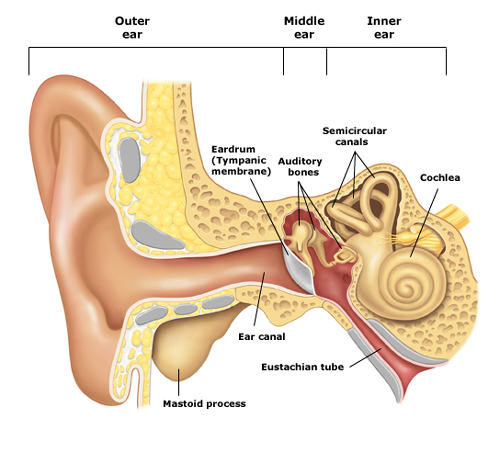Our team of physicians and audiologists will carefully examine your unique hearing needs and collaborate together with you to find your best fit. There are a broad range of hearing solutions including:
- Surgical Correction
- Cochlear Implants
- Hearing Aids
- Hearing Aid Accessories
- Bone Anchored Hearing Aids
- CROS or BiCROS Aids
Read more about your area of interest using the navigation links.

Ear Anatomy
When describing ear anatomy we refer to three main sections:
- Outer Ear
- Middle Ear
- Inner Ear
The outer ear consists of the auricle, external auditory canal, and tympanic membrane (eardrum).
The middle ear consists of the three smallest bones (auditory ossicles) in the human body: the malleus, incus, and stapes. The eustachian tube connects the middle ear to the nasopharynx with the primary function of equalizing pressure on the eardrum from the external auditory canal and the middle ear.
The inner ear consists of three semicircular canals, utricle, saccule, and the cochlea. The vestibulocochlear nerve (balance and hearing nerve) travels from the inner ear into the brain.
Function of Hearing
Hearing is a process of converting air-vibrating sound wave energy to electric nerve signals that the brain can interpret. The outer ear of a human enhances high frequency perception from the front, and de-emphasizes the higher frequencies from behind. The external ear canal conducts sound to the ear drum membrane, tucking its delicate membrane away from potential trauma. If the external auditory canal is plugged with earwax, the hearing can be notably reduced. Sound waves striking the tympanic membrane (eardrum) alternately push and pull the tightly drawn, but soft membrane, transferring energy to hearing bones suspended on very soft ligaments in the middle ear. The third hearing bone, the stapes bone, direct transmits sound through the oval window of the inner ear setting inner ear fluids in motion at the same frequencies as the incoming sound. This energy separates out inside the hearing part of the inner ear, called the cochlea. Tiny “haircells” are structured to optimize specific frequencies in specific areas of the cochlea. These hair cells convert the fluid waves to electrical signals which transfer to the auditory branch of the vestibulocochlear nerve and send electronic signals to the brain for sound interpretation.
Function of Balance
The vestibular (balance) system allows humans to maintain balance, maintain orientation, and respond to movement. The three semicircular canals of each ear respond to acceleration and deceleration at any angle of motion of the head. The utricle and saccule respond to changes in any linear acceleration and deceleration of the head. These latter two organs are also very sensitive to tilt in any direction, telling the inner ear and brain the direction of gravity.